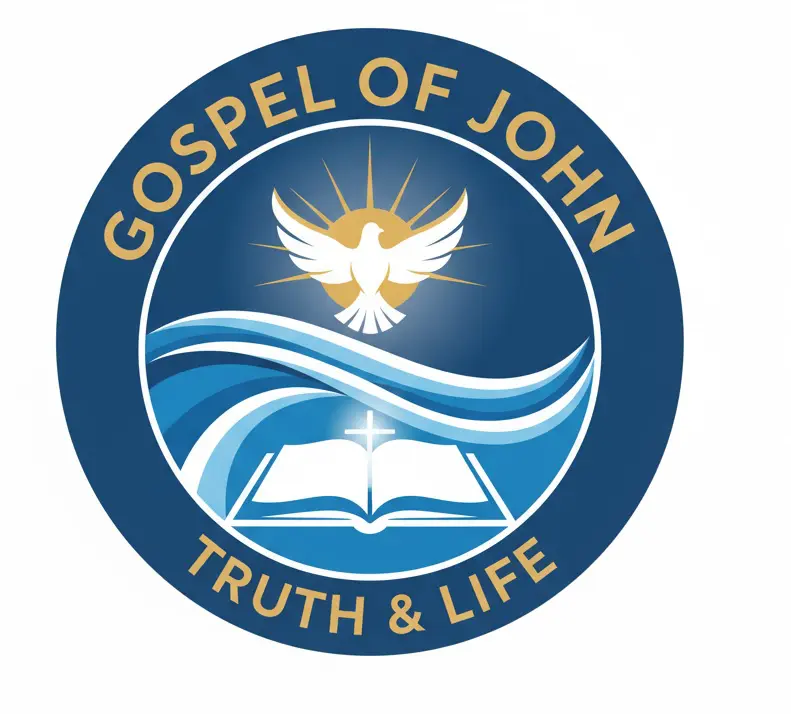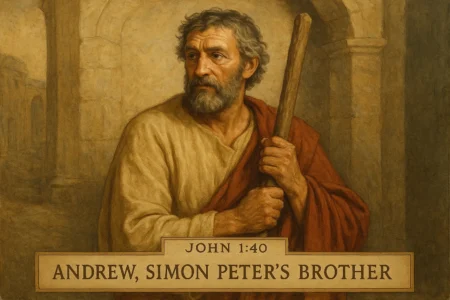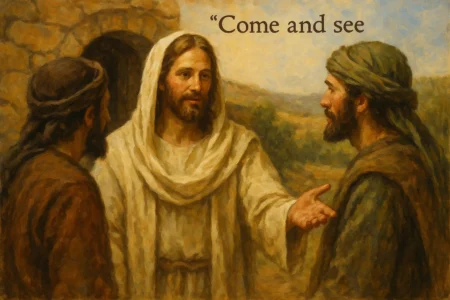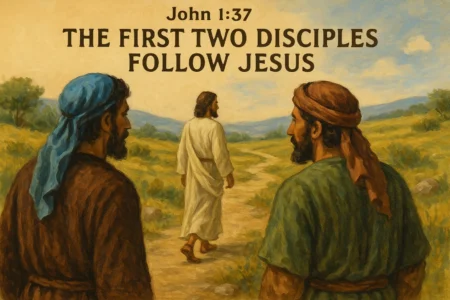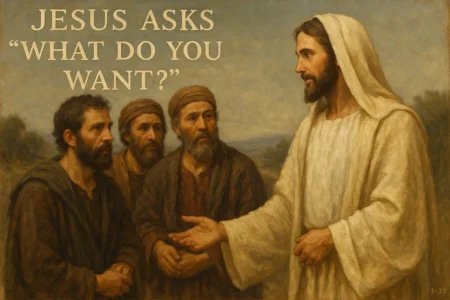There are moments in life that change everything. A pivot point. Sometimes it’s a quiet conversation, other times it’s a public declaration that draws a line in the sand. For the followers of a strange, camel-hair-wearing prophet baptizing people in the Jordan River, that moment comes in the thirty-fourth verse of the Gospel of John’s first chapter. After days of buildup, of deflecting, of pointing away from himself, John the Baptist finally points to someone. He sees Jesus, and the testimony he gives is the axis on which the entire Christian faith begins to turn. He declares, “And I have seen and have borne witness that this is the Son of God.”
This single sentence is more than just an introduction.
It’s a verdict. It’s a divine identification. Exploring the John 1:34 meaning is to dig at the very root of the question Jesus himself would later ask: “Who do you say that I am?” John the Baptist gives his answer, and it’s an answer that would cost him his life and shape the next two millennia of human history. This wasn’t just a casual opinion. It was a formal, eyewitness testimony, and understanding it is key to understanding who Jesus claimed to be.
More in John Chapter 1 Category
Key Takeaways
- This verse is the absolute peak of John the Baptist’s testimony. It’s where he stops pointing away from himself and points directly at Jesus, identifying him as “the Son of God.”
- This wasn’t John’s personal opinion. He makes it clear his testimony is based on a specific, divine sign he was told to look for: the Holy Spirit coming down and staying on Jesus like a dove.
- “Son of God” isn’t just a nice title. In the context of John’s Gospel, this is a massive claim about Jesus’s unique, divine nature and his eternal relationship with the Father.
- This verse connects who Jesus is (“Son of God”) with what he came to do (“Lamb of God,” v. 29). John is saying only this divine Son could be the perfect sacrifice for the world’s sin.
- John’s act of “bearing witness” (from the Greek martyria) is a legal, public, and formal declaration, setting the theme of “witness” that defines the entire Gospel of John.
Who Exactly is Speaking in John 1:34, and Why Should We Listen?
First things first, let’s get our Johns straight. The man speaking this verse is not John, the disciple who wrote this Gospel. This is John the Baptist, a figure who stands as the final prophet of the Old Covenant, a bridge to the New.
He’s a fascinating character. A man of the wilderness, he ate locusts and wild honey and preached a fiery message of repentance. Crowds flocked to him. The religious leaders in Jerusalem were so intrigued (and nervous) that they sent a formal delegation to ask him point-blank: “Who are you?” (John 1:19).
And this is why we should listen: his answer.
In a world obsessed with building a personal brand, John’s entire ministry was about de-platforming himself. He says, “I am not the Christ” (1:20). He’s not Elijah. He’s not “the Prophet.” He’s just “the voice of one crying out in the wilderness, ‘Make straight the way of the Lord’” (1:23).
His humility is disarming. He is the best man, not the groom. His entire purpose is to point to someone else. It reminds me of a time in my old job when my boss gave me a really tough message to deliver to the team. I had to stand up there and relay the news, and I made it clear, “This isn’t from me, I’m just the messenger.” That sense of duty, of just being the guy delivering the message, is powerful. John’s entire life was that, on a cosmic scale.
So, when this man, whose whole identity is built on not being the guy, suddenly stops and points at someone and says, “This is the guy,” it carries immense weight. He’s the ultimate “character witness” for Jesus, precisely because he has no interest in stealing the spotlight.
What Did John the Baptist Actually See?
This testimony in John 1:34 isn’t a hunch. It’s not a gut feeling or a good guess. It is the conclusion of a divine revelation. John’s credibility rests on the fact that he is an eyewitness to a specific, pre-arranged sign.
He explains it himself in the preceding verses. In John 1:32-33, he says: “I have seen the Spirit descend from heaven like a dove, and it remained on him. I myself did not know him, but he who sent me to baptize with water said to me, ‘He on whom you see the Spirit descend and remain, this is he who baptizes with the Holy Spirit.’”
John essentially lays it all out. “Look, I didn’t even know him personally. But the same God who sent me to baptize with water gave me a secret sign. He told me, ‘You’re going to be baptizing, and at some point, you will see the Spirit come down from heaven and land on a man. And it won’t just touch him; it will remain on him. When you see that happen, that’s your guy. That’s the one who will baptize with the Holy Spirit.'”
And then, John says, it happened. Right there in the Jordan. He saw Jesus come to him, he baptized him, and—boom—the sign was given. The heavens opened, the Spirit came down, and it stayed. This visual confirmation is his evidence. This is what gives him the authority to move from “I am not the Christ” to “This is the Son of God.”
It was not a guess.
Why a Dove? What’s the Big Deal About the Spirit Descending?
The imagery here is incredibly rich, packed with Old Testament meaning. The Spirit descending “like a dove” isn’t just a random, gentle image. This symbol would have resonated deeply with any Jew who knew their scriptures.
Think back to the very beginning. In Genesis 1:2, as God begins creation, the “Spirit of God was hovering over the face of the waters.” A new creation was dawning.
Now think about the last time the world was covered in water. After the great flood, how did Noah know the judgment was over and a new, clean world was ready? A dove. It returned with an olive branch (Genesis 8:11), a symbol of peace between God and man.
This dove at Jesus’s baptism signifies both. It is the dawn of a new creation. It is the sign of ultimate peace. But most importantly, it is the royal anointing. In the Old Testament, prophets, priests, and kings were anointed with oil to set them apart for God’s service. Here, Jesus is anointed for his ministry not by a prophet with oil, but by God himself with the very Spirit of God.
This is the anointing of the Messiah (which literally means “Anointed One”). The Spirit doesn’t just visit him; it remains on him. He is the permanent carrier of God’s Spirit, the one who, as John says, will “baptize with the Holy Spirit.” This visual event is the divine stamp of approval, commissioning Jesus for his work.
“Son of God” – Wasn’t This a Common Title?
This is the absolute heart of the John 1:34 meaning. Is John just calling Jesus a good, godly man? Or is this something more?
It’s true that the title “son of God” (lowercase) was used in the Old Testament to describe others. Angels were called “sons of God.” The nation of Israel was called God’s “firstborn son.” The Davidic King was adopted as God’s son in Psalm 2:7.
So, skeptics might argue John is just calling Jesus the long-awaited King, the Messiah, in a human sense.
But the Gospel of John won’t let us stop there.
The author, the apostle John, spent his entire prologue (John 1:1-18) making a case for something far more radical. He already told us, “In the beginning was the Word, and the Word was with God, and the Word was God” (1:1). And, “the Word became flesh and dwelt among us” (1:14). And that this Word is the “only Son from the Father” (1:14, 1:18).
When John the Baptist declares Jesus is “the Son of God,” he is using the apostle John’s definition. This isn’t just a royal title. It’s a declaration of divine nature. As various theological and academic resources, like the Stanford Encyclopedia of Philosophy’s entry on Christology, explain, this term in the New Testament took on a meaning far beyond its Old Testament roots. He is not a son of God, like the rest of us can become. He is the Son of God, unique, eternal, and one with the Father.
For a long time in my own spiritual journey, “good teacher” or “great prophet” was a comfortable label for Jesus. “Son of God” was not. It felt too big, too demanding. It required a complete shift in my understanding of God and reality. But the Gospel of John makes it clear that this is the central question. John the Baptist, guided by the Holy Spirit, gives the definitive answer.
How Does “Son of God” Connect to “Lamb of God”?
You can’t understand the testimony in verse 34 without reading what John said just a few lines earlier.
On the previous day, John saw Jesus and shouted, “Behold, the Lamb of God, who takes away the sin of the world!” (John 1:29).
These two titles are not separate. They are two sides of the same coin, explaining both the person and work of Jesus.
Think of it this way:
- “Lamb of God” is his mission. It’s his job description. He is the ultimate sacrifice, the fulfillment of all the Passover lambs and temple sacrifices. His purpose is to die for sin.
- “Son of God” is his identity. It’s his resume. It’s what makes him uniquely qualified for the job.
A normal lamb, a mere human, or even a prophet couldn’t be the final sacrifice for the entire world. The sacrifice had to be perfect, spotless, and of infinite value to cover an infinite debt. Only the divine Son of God, the one who was God, could be the perfect Lamb of God.
The titles are inseparable. His identity as the Son validates his mission as the Lamb.
What Does it Mean to “Bear Witness”?
John says, “I have seen and have borne witness…” This phrase is so much more powerful than it sounds in English.
The Greek word used here is martyria. It’s where we get our word “martyr.”
This is not “I’m sharing my feelings.” It’s not “Here’s my hot take.” This is a legal, formal, public testimony. John is figuratively standing in a courtroom, placing his hand on a Bible, and swearing under oath. He is an eyewitness, and this is his sworn statement.
I once had to testify in a minor court case after witnessing a traffic incident. Even for something so small, the weight of “bearing witness” was intense. The lawyer on the other side grilled me. I couldn’t guess or say “I think.” I had to state only what I saw. My words had legal consequences.
John is doing this on a cosmic scale. He’s not guessing. He is stating, under a divine commission, what he saw and what was revealed to him. This concept of “witness” is arguably the most important theme in the entire Gospel of John. The author uses the word “witness” (in its various forms) nearly 50 times. John the Baptist is the first witness. Then the disciples become witnesses. The miracles (or “signs”) are witnesses. The Father himself is a witness.
It all starts here.
But John Doubted Later, Didn’t He?
This is a fair and important question. It’s the “elephant in the room” for John’s testimony. Later in the story, in Matthew 11, we find John the Baptist in prison. Things aren’t going as expected. This Jesus isn’t overthrowing the Romans or setting up a political kingdom. He’s just… healing people and talking about love.
So, John sends his disciples to Jesus with a desperate, human question: “Are you the one who is to come, or should we look for another?” (Matthew 11:3).
Does this moment of doubt invalidate his rock-solid certainty in John 1:34?
Absolutely not. In fact, I think it makes his testimony more trustworthy. It shows he was human. He was trapped in a dungeon, and his own human expectations were being challenged. He was wondering why the “Son of God” wasn’t acting like the conquering king he expected.
And what is Jesus’s answer? He doesn’t just say “Yes.” He points back to the evidence, the same standard John used. “Go and tell John what you hear and see: the blind receive their sight and the lame walk, lepers are cleansed and the deaf hear, and the dead are raised up, and the poor have good news preached to them” (Matthew 11:4-5).
Jesus basically says, “The evidence is still coming in. The anointing you saw is real, and here is the fruit of it.” John’s doubt was human. His testimony in John 1:34, however, was divine.
How Does the John 1:34 Meaning Apply to Us Today?
This verse isn’t just a dusty piece of theological history. It’s the model for all Christian testimony. John’s witness provides a powerful template for us.
What’s the takeaway? John’s testimony is a blueprint. It’s not about him; it’s about Jesus. He pointed away from himself and to Christ. It’s not based on his own ideas; it’s based on what he saw and was told by God. For us, our witness is based on what God has revealed in Scripture and how we have seen that truth work in our own lives. And it’s not quiet; it’s a bold, public statement, even when it’s not popular.
The claim is the same today as it was then. Jesus is not just one of many options. He is not just a good teacher or a moral guide. The testimony of John the Baptist, the testimony of the apostles, and the testimony of the Gospel itself is that He is the “Son of God.”
To be a Christian is to agree with John’s testimony. It is to say, “Yes, I believe that too.” This central claim is the dividing line. For anyone seeking to understand the faith, this is the place to start. You must, as we all must, decide what to do with the testimony of John the Baptist.
What If I Still Struggle with the Title “Son of God”?
If you find this title to be a stumbling block, you are in good company. It’s the most profound claim in history. The entire Gospel of John was written for you.
The apostle John, the author, states his purpose explicitly at the end of his book. He says he wrote all these things “so that you may believe that Jesus is the Christ, the Son of God, and that by believing you may have life in his name” (John 20:31).
Notice the parallel. The book begins with John the Baptist’s testimony (1:34) and ends with the author’s stated purpose (20:31). The entire book is an invitation to examine the evidence, just as John the Baptist examined his one great sign.
The Gospel doesn’t just say “Believe this!” It says, “Look at the signs.” Look at the water turned to wine. Look at the royal official’s son healed from a distance. Look at the invalid healed at the pool, the 5,000 fed with a boy’s lunch, the man born blind given sight.
Look at Lazarus, dead for four days, walking out of his tomb.
The author of this Gospel, a man who lived with Jesus for three years, is presenting his own “witness” account. He is compiling the evidence, slide by slide, and laying it before you. He is inviting you to reach the same conclusion as the Baptist: This man is different. His works, his words, and his love point to one, stunning reality.
The Final Verdict
The John 1:34 meaning is the bedrock of the Gospel. It is the first formal, human identification of Jesus as divine. John the Baptist, the greatest of the old prophets, sees the one he was sent to prepare for. He sees the sign. And he delivers his testimony.
“I have seen and have borne witness that this is the Son of God.”
It’s a statement that hangs in the air, spoken two thousand years ago and still echoing today. It’s a testimony that demands a response. John has made his case. The apostle has made his. The evidence has been presented.
Now, the decision rests with us.
FAQ
Who is speaking in John 1:34 and why is their testimony important?
The speaker in John 1:34 is John the Baptist, not the Gospel writer. His testimony is important because he is an eyewitness who, guided by divine revelation, distinctly identifies Jesus as the Son of God based on a specific sign—the Spirit descending and remaining on Jesus.
Why is the title ‘Son of God’ so significant in understanding Jesus?
The title ‘Son of God’ signifies Jesus’ divine nature and his eternal relationship with God, setting him apart from other figures who were called sons of God in a lesser, non-divine sense, highlighting his unique and divine identity.
How does John the Baptist’s recognition of Jesus as the Lamb of God relate to his declaration as Son of God?
John the Baptist’s declaration as the Lamb of God emphasizes Jesus’ mission to die for sin, while his title as Son of God affirms His divine identity; together, they reveal both Jesus’ divine nature and his purpose as the sacrificial Savior.
What does it mean to ‘bear witness’ in the context of John 1:34?
To ‘bear witness’ means to provide a formal, legal, and public testimony based on eyewitness experience, affirming that what John saw—the Spirit descending and remaining on Jesus—is divine evidence of Jesus’ identity as the Son of God.
